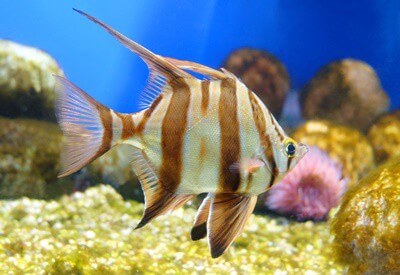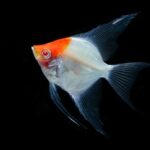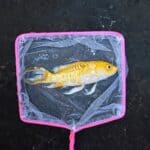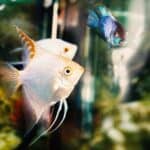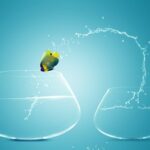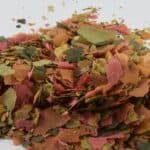Last Updated on: 17th October 2023, 10:37 am
Ammonia is a chemical you don’t want in an angelfish tank. While it’s common in most aquariums, high levels are a problem. Angelfish become unwell if exposed to ammonia for too long.
Ammonia is toxic to angelfish. When the tank’s pH levels are between 6.8 and 7.8, ammonia is harmless and naturally converted into nitrite by beneficial bacteria in the tank.
However, ammonia can become toxic due to fish over-stocking, over-feeding, decaying organic matter, poor tank hygiene, and fish excrement.
Ammonia can lead to bacterial infections, diseases, or death if not removed from the tank. If you own angelfish, regularly test the tank’s water to monitor pH, ammonia, and nitrite levels.
Does Ammonia Burn Angelfish?
Ammonia (NH3) is a toxic nitrogenous waste found in most aquariums. It kills fish at high levels and causes many diseases and infections that are often fatal.
Ammonia poisoning is common, especially in new tanks. When ammonia reaches dangerous levels, it chemically burns the fish’s skin, eyes, gills, tail, and fins.
Angelfish increases the mucus they produce to ease the pain and relieve the burns.
The mucus coats the gills, making it difficult for fish to absorb oxygen. In some cases, fish die from suffocation. Painful bacterial infections can also develop from ammonia burns.
Younger angelfish are most at risk. In a study published by the Fresenius Environmental Bulletin, a team of researchers found that the mortality rate of juvenile angelfish increased as soon as they added larger amounts of ammonia to the tank.
The toxicity of ammonia depends on the angelfish’s:
- Age.
- Acclimation history.
- Water-quality parameters.
Other studies have shown that ammonia poisoning causes intense physiological distress in various species of fish, which often causes long-lasting mental damage.
How Fast Does Ammonia Poisoning Kill Fish?
Most fish owners observe signs of ammonia poisoning within 2-3 days. It takes a few days for the chemicals to start burning the fish. Once the burns set in, the effects are rapid.
How fast ammonia poisoning kills fish depends on the tank’s size, weight, age, and ammonia levels. However, it’s common for the entire aquarium to die within a week.
If you remove ammonia from the tank before it kills the fish, they’re not necessarily safe. You’ll need to monitor for bacterial infections that may develop as a result of the toxicity.
Bacterial infections kill more slowly than ammonia poisoning and are highly distressing for the fish.
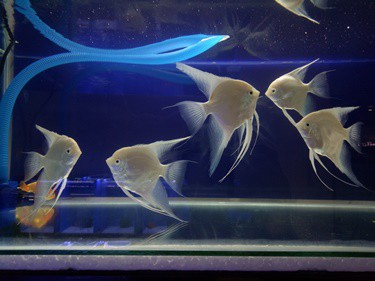
What Are Safe Angelfish Ammonia Levels?
There is no such thing as a “safe level” of ammonia. All ammonia can become toxic quickly.
In healthy tanks, ammonia is present but converted by beneficial bacteria into nitrite, a less harmful toxin. A second beneficial bacteria then converts nitrite into nitrate.
While the names are similar, they’re two very different chemicals.
Nitrite is harmful in large quantities, whereas nitrate isn’t usually something to worry about. It’s naturally cleared out of tanks through water changes.
However, to prevent ammonia, ensure your tank’s pH levels are between 6.8 and 7.8. Ammonia found in water with a higher pH than the safe levels is toxic.
Therefore, angelfish ammonia levels should be removed or diluted once you know they’re there. Sometimes, ammonia levels can be high but not affect the fish. However, it’s not worth the risk. Remove ammonia as soon as you can.
Testing Ammonia Levels
Ammonia is invisible, so it isn’t easy to test without the right equipment. The only accurate way to test for ammonia is to use a reliable kit.
Aquarium testing is one of the most important things you can do and should become a central part of your cleaning routine. Without testing, it’s impossible to know if toxins are in the tank’s water.
You can purchase API kits from local pet stores. They’re inexpensive and allow fish owners to see whether ammonia levels are above zero.
To use one, place some of the tank’s water into the test tube provided with the test and add a few drops of the testing solution. Shake the mixture to make it change color.
A color chart with the test will tell you the ammonia level in the water.
You can also purchase test strips, which are slightly cheaper and easier to use. Dip the strip into the tank’s water and check the colors to determine the results. However, most experts agree that test strips are less accurate than traditional tests.
If you don’t have access to a testing kit, seek advice from your fish seller, who may be able to help you carry one out.
Without a kit, you can’t accurately check ammonia levels in a fish tank, but understanding the signs of ammonia poisoning can help you determine when something’s wrong inside your aquarium.
What Causes Ammonia In Fish Tanks?
There are several causes of ammonia in tanks, most of which can be controlled with good care and tank management. The main reasons for ammonia poisoning include:
New Tank
New tanks must go through the cycling process to make it safe for angelfish to live in.
However, new aquariums and filtration systems lack the beneficial bacteria that keep ammonia levels safe by breaking down toxins inside the tank.
Tanks between 1 to 20 days old are most at risk, mainly because the bacteria haven’t had enough time to establish. This raises the chance of ammonia becoming toxic.
Similarly, new biofilters can’t reprocess ammonia immediately, allowing the toxin to accumulate.
Therefore, angelfish must be introduced gradually to a new tank. This allows the biofilter to start regulating the aquarium while the fish acclimate to their new home.
At the same time, keep testing the water. The first few weeks are crucial to your tank’s health.
Fish Excrement
Ammonia is a waste product released by fish through their excrement and gills. An angelfish’s urine and feces are nitrogenous and break down into ammonia.
It’s not usually an issue because waste products become diluted inside the tank due to the volume of water per fish. In the right quantities, angelfish poo provides nutrients that keep the ecosystem inside the aquarium healthy. However, too much allows high ammonia levels to infiltrate the tank.
Harmful amounts of angelfish excrement in the tank are commonly caused by too many fish or tanks that are too small for the number of fish inside.
Over-Stocking
Over-stocking a tank with too many angelfish and other species causes several problems.
It’s also among the leading causes of ammonia in aquariums. While getting excited about having lots of fish is natural, you must be realistic about how many you can have.
While filter systems remove ammonia from a tank, they have their limits.
When too many fish are in one place, the filter must quickly convert ammonia into nitrite. But sometimes, the system can’t do it on time, causing harmful ammonia spikes.
Even if the filter converts ammonia into nitrite before it rises to dangerous levels, nitrate in the tank increases faster than it should. This weakens the immune system, exposing them to diseases.
When stocking your tank, aim for the one-inch per gallon rule. It’s a rough estimate, but it leaves room for the filtration system and plants and ensures the fish have enough space to swim and claim territory.
Over-Feeding
Similar to over-stocking, over-feeding creates high levels of ammonia. The protein in uneaten food breaks down into ammonia, but too much of it turns toxic.
Adding extra food for later isn’t healthy. Instead of serving as a tasty snack when your angelfish are hungry, the food disintegrates and falls apart in the water, rendering it inedible.
Microbes begin to decompose the food, releasing ammonia into the tank.
If your angelfish overeat, they suffer from digestive issues, increasing the amount they defecate. Once again, this causes a build-up of harmful ammonia and disrupts the balance of the tank’s ecosystem.
Decomposing Organic Matter
According to the Global Agriculture Alliance, organic matter decomposition creates an oxygen demand and releases ammonia into the water.
When organic matter, such as plants and food, begins to decay and rot, excess nutrients, including ammonia, are released into the tank.
Dead fish also affect water quality, particularly if they’ve been in the aquarium for a while. Some angelfish die in hard-to-reach places within the tank and aren’t found until they cause problems.
If you can, remove dead angelfish as soon as you find them before they begin to rot. Also, clean up decomposed plants when you cycle your tank.
That’ll keep the water clean and toxin-free. Remove all traces of uneaten food, too.
Signs of Ammonia in Fish Tanks
While ammonia can’t be seen, it’s quick to affect angelfish in the tank. Testing is the only way to know for sure if ammonia is present, but these are signs to look out for if you suspect ammonia in your aquarium:
Foul Odor
Ammonia has a distinctive smell similar to cat urine or vinegar. It’s unpleasant and can be intense if the ammonia levels are high. However, you can still smell it, even with small amounts of ammonia in the tank.
If you smell ammonia, you must act fast to save the fish.
In some cases, a foul odor means it’s already too late. If you’ve detected a faint smell early, you can remove toxins from the tank and prevent the angelfish from becoming sick.
Gasping at the Surface
When ammonia is in the tank, their gills become less effective at extracting oxygen.
Fish gasp for air at the surface of a tank when they can’t breathe very well. When this happens, they’re in survival mode and won’t live for very long unless you intervene.
The mucus generated to relieve ammonia burns also damages the gills and internal organs. When the gills are covered with thick mucus, angelfish struggle to breathe.
As well as gasping for air at the surface, angelfish affected by ammonia may rest on the substrate, where the oxygen concentration levels are at their highest.
Lethargy
When your angelfish’s ability to breathe is impacted by ammonia, it’s exhausting for the fish to continue to swim without enough oxygen. Similarly, as their bodily functions fail, they become lethargic.
As a result, the fish may appear motionless and stop swimming.
You might notice your angelfish floating inside the tank, which causes the fish to look dead. Tired angelfish also sometimes prefer to lay at the bottom of the tank amongst the substrate.
Lack of Appetite
Ammonia poisoning can also cause your angelfish to lose their appetite.
A lack of nutrition causes other health problems alongside ammonia poisoning. Your fish should eat again once the water’s pH is normal. If not, exposure to ammonia may have caused long-term damage.
Red or Cloudy Eyes
Prolonged exposure to ammonia can turn an angelfish’s eyes red or cloudy. Redness is usually a direct result of chemical burns. However, cloudiness is more commonly caused by a bacterial infection caught by the fish due to its compromised immune system.
To reduce the chances of a bacterial infection once you’ve treated the tank’s ammonia, follow these steps:
- Add active carbon filtration to the tank.
- Remove debris and decaying matter from the tank.
- Clean all filters of solid waste.
- Improve the fish’s diet by only feeding high-quality food.
Redness Around Gills
The mucus covers the gills, making the skin look pale. But ammonia poisoning also causes red spots around the gills where damage has been done.
These red patches are burn sores and are painful for angelfish.
Not only that, but they can become infected. They might also bleed into the tank, tainting the water.
Sudden, unexplained markings on the body rarely appear naturally and should be monitored for other signs of illness. Redness is usually a sign of burning or internal bleeding and must be treated.
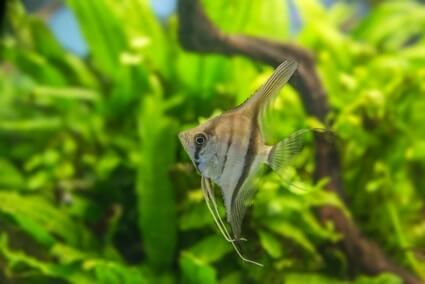
How To Remove Ammonia From Fish Tank
Ammonia is relatively easy to remove once you know it’s there. However, you must act quickly to prevent your fish from dying. Once the foul ammonia odor has gone, your tank should be on its way to becoming healthy.
Ammonia poisoning can kill in a matter of days. You can’t leave it to get better, or the angelfish will suffer. Death caused by ammonia is painful.
To remove ammonia from your tank, follow these steps:
- Get a biological filter to break down the ammonia.
- Change the water every other week to maintain water quality.
- Vacuum the gravel or substrate for any traces of decaying matter.
- Remove uneaten food or rotting plants.
- Unclog all filters.
- Remove fish from the tank if over-stocked and move them to a separate aquarium.
- Frequently measure the ammonia levels using a reliable kit to make sure the toxin hasn’t returned.
- Use an ammonia binder in the water of a new aquarium, adding fish, or during cleaning.
The best thing you can do for your angelfish is to monitor the toxin levels in the aquarium. As soon as they start creeping up, you can act quickly before the fish become affected.
Can Fish Recover from Ammonia Poisoning?
Sadly, ammonia poisoning is impossible to cure. The only way to stop your fish from suffering is to prevent ammonia from accumulating inside the tank.
The long-term side effects of ammonia poisoning include:
- Infections.
- Blindness.
- Recurring sores.
- Compromised immune system.
- Difficulty breathing.
- Torn fins.
Ammonia poisoning isn’t always fatal. While angelfish may suffer from recurring health problems, they can still lead happy, healthy lives with the appropriate treatment and palliative care.
When treating affected angelfish for poisoning, isolate them using a separate quarantine tank and administer an antibiotic or antibacterial medication. Seek advice from a vet beforehand, who can give you the right medicine for the severity of your fish’s condition.
When administering medicine, do it in a separate tank with only the most severely affected fish. It’s not something all fish will need. Treatment typically takes three to five days to work.
Look out for signs of improvement, including:
- Steady breathing.
- Normal swimming behavior.
- Improved appetite.
- Overall brightness and better mood.
The above signs indicate that your angelfish is settling back into the tank and is recovering from the damage caused by ammonia.
When To Do A Water Change During Cycling
Water changes should be carried out on a bi-weekly basis. When you do, replace 10% to 20% of the tank’s volume with fresh water.
Dechlorinate the water and scrub the tank’s insides thoroughly to remove traces of algae or harmful build-up.
Also, while cleaning the tank, siphon waste that has settled on the substrate before decomposition. This will keep harmful ammonia, nitrite, and nitrate levels away from the water.
Don’t forget to clean out the filter. This part is overlooked but can cause many problems if left uncleaned.
However, you need to be careful not to remove the beneficial bacteria inside the filter that helps to regulate the tank. These bacteria are essential to your tank’s health.
Using the existing tank water to remove all gunk and slime is sufficient. Don’t run the filter under a faucet because you could kill the good bacteria needed to keep the tank healthy and clean.
Ammonia is one of the main challenges that angelfish owners face. It develops quickly and causes a significant amount of damage.
Fish left untreated suffer, so if you notice they’re unwell, identify the cause and resolve the problem.

